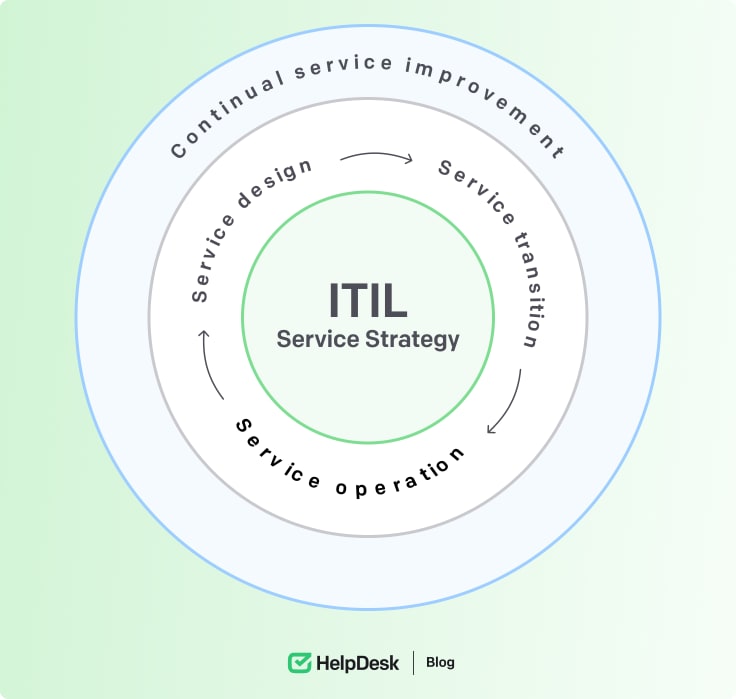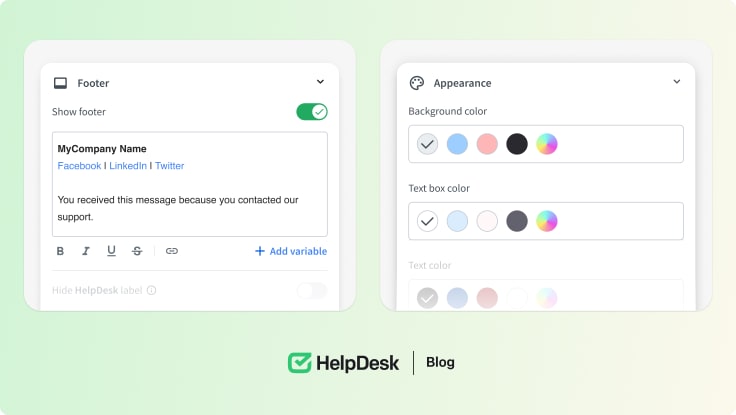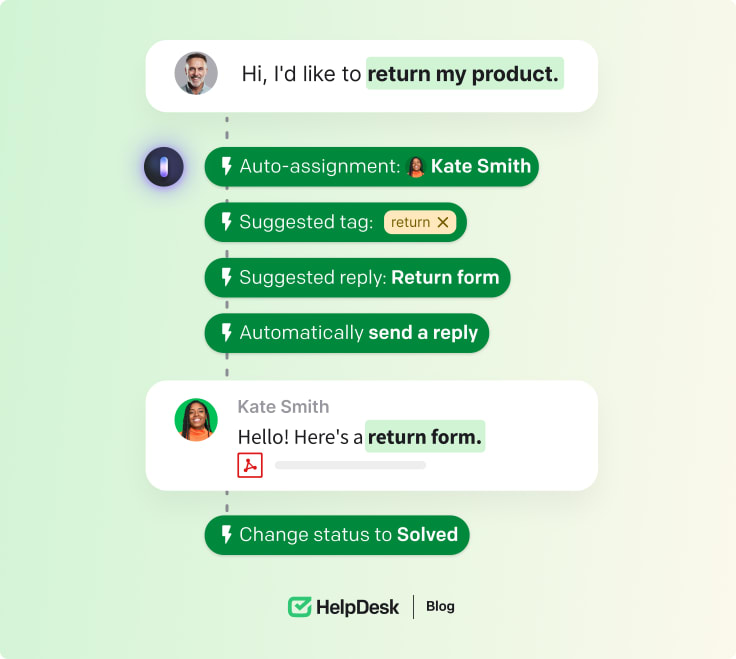A service desk is a necessity for any company with IT infrastructure. However, having an IT service desk is just the beginning, as it’s beneficial to establish an Information Technology Infrastructure Library (ITIL) service desk that aligns with industry best practices.
To understand why and what these practices are, I’ll run you through everything you need to know. Before moving on to ITIL service desk guidelines, let’s cover what a service desk means.

What are service desks?
A service desk is a centralized service that helps users with IT-related queries within a business. It provides incident and service management and handles client service requests. A service desk is essentially a management interface for IT departments.
An ITIL service desk is set up in line with ITIL — a list of standardized best practices within the IT industry. Implementing a platform that uses these practices ensures end-users get the best service possible.
ITIL framework and service lifecycle
Helpfully, ITIL provides an entire service lifecycle for products that consists of five stages.
These are:
-
Service strategy.
-
Service design.
-
Service transition.
-
Service operation.
-
Continual service improvement.
Discussing these in too much detail is unnecessary, as they are self-explanatory. What is worth mentioning, though, is that each has its own ITIL best practices to ensure they’re implemented smoothly and in line with the general ITIL guidelines.
IT service desk processes
Although five processes are covered in the ITIL service desk guidelines, only two are the specific responsibilities of service desk staff. These are incident management and request fulfillment — the core services of service desks.
Incident management
Incident management is the service desk process of managing internal and external incidents from beginning to end.
Some examples include:
-
Users not being able to log in.
-
Internet connectivity issues.
-
Corrupted data.
-
Hacks.
-
Loss of service use.
The purpose of incident management from a service desk perspective is to return services to end-users as quickly as possible. Service desks help with this through their ticket functionality, as users can log and track incidents on a centralized platform.
Request fulfillment
Request fulfillment, or service request management, handles user requests. Unlike incident management, which involves responding to issues, request management focuses more on non-threatening topics.
These might include:
-
Access to applications.
-
Password resets.
-
New hardware.
-
Access to software licenses.
Request fulfillment is often less time-sensitive than incident management, which is another reason service desks are helpful here. Ticketing systems on service desks should allow IT personnel to prioritize tasks to deal with critical issues while also providing users with information regarding their requests.

Service desk software and tools
Effective and efficient service desk software is essential for proper IT service management (ITSM) within an organization. While this makes the most sense for IT-focused companies, any company that uses IT processes for everyday work should have a robust service desk system.
Ease of use
Unsurprisingly, service desks should be easy to use, particularly for non-IT personnel. More than anything, they might not be as familiar with complex systems as IT people, so a practical service desk should be as simple to use as possible.
Reporting systems
Similarly, a service desk should have an effective reporting system, which is its primary function. This might include a shared inbox for IT staff, a straightforward ticketing system, and priority flagging for incidents. IT staff should be able to communicate with each other and with customers without difficulty inside the service desk software.
Knowledge management
Knowledge management is just as important because it allows for effective collaboration between IT personnel. Similarly, it ensures user consistency and can help organizations develop their interpretations of best practices. If nothing else, your service desk software should come with an easy-to-use handbook.
Discover more features of HelpDesk that might help you enhance your customer support. 🚀 All your customer communication in one place. 💻
Best practices for an IT service desk
ITIL has a helpful list regarding best practices for an IT service desk.
The most important points are:
-
Establishing a single point of contact for end-users.
-
Offering timely and practical support for service requests.
-
Continuously improving service desk processes.
-
Aligning the service desk with business objectives and priorities.
-
Understanding customer needs and expectations (such as ease of use).
-
Defining a service catalog and service level agreements.
It might sound like a lot to juggle when implementing a service desk, but it’s pretty easy. Generally, a base platform will align with most of these practices straight out of the box. You only have to tweak continuous improvement and alignment with your business objectives.
The easiest help desk system for a team like yours
Discover HelpDesk
IT service desk implementation and optimization
The process should start by clearly understanding your business objectives and priorities, as these will form the foundation of the platform you use. For example, your objectives might be a certain level of productivity, which could be affected by employee downtime.
From there, ITIL service desk implementation should go through a thorough analysis of your current process. This allows you to identify areas for improvement. One example could be your service desk communication channel, which might lack a centralized shared inbox. Adding this feature would be classed as optimization.
Next, you’ll want to train and develop service desk staff. It should include learning your service desk software and customer service best practices. After all, IT staff will be interacting with end-users, and it’s always helpful for them to be good at this aspect of the job.
Finally, you’ll want to monitor and optimize your processes continuously. Analysis is a good start, and you should use your objectives to set KPIs and metrics. These and reporting give you a solid foundation for smooth optimization.
Service desk metrics and reporting
Let’s look at some of the most straightforward metrics to define and monitor within a service desk. Metrics include:
-
Customer satisfaction.
-
Time to resolve.
-
Tickets open vs. solved.
-
Backlog rates.
-
Transfer rates.
Most metrics look at how quickly and effectively incident reports and service requests are handled. These rates directly impact secondary metrics, such as customer satisfaction.
Reporting should happen at least weekly, but you’ll also want to look at daily, monthly, and quarterly reports. These will be based on the metrics above and also overall performance. You can identify and track trends that feed into your defined KPIs from these.
Overall, metrics and reporting continually improve your service desk procedure. Reports should include recommendations to make this easier, which can be automated or human-generated.

Overcoming standard IT service desk challenges
Every service desk implementation has its challenges. While you’ll never altogether avoid them, knowing about them in advance will at least help you be prepared.
The main challenges for service desks are lack of resources, lack of training, and poor communication. Luckily, these are relatively easy to solve if caught in time, so it pays to be proactive.
ITIL service desk best practices can help avoid these challenges. They provide a framework for effective delivery of the end product, and, as mentioned above, they cover aspects such as training and centralized communication tools.
Similarly, implementing a service desk based on ITIL best practices can improve customer satisfaction and reduce costs while increasing collaboration between IT personnel and business units.
There’s not much more to say on this because if you follow best practices, your risk of facing service desk challenges is minimal. The key is to implement a platform with this framework built in, as it’ll save you reactively dealing with issues as they pop up.
IT service desk roles and responsibilities
The role of an IT service desk is to manage the complete lifecycle of incidents and service requests. This includes managing IT services, implementing new ones, dealing with IT incidents, and supporting customers and employees.
A centralized and effective platform is critical because IT assets and satisfied customers are precious. A service desk should be available 24/7 for uninterrupted services, which can also help keep costs down.
Finding a platform that offers all this (and more) can be challenging. Luckily, HelpDesk has you covered. The HelpDesk service desk is built from the ground up on ITIL best practices to ensure excellent customer service and efficient support are ingrained in its processes.
It includes efficient ticket management, prioritization, and easy issue resolution. Asynchronous communication features, automation, feedback collection, and more are also included.
HelpDesk offers proactive outreach, allowing your IT staff to contact customers before incidents arise. Providing this level of assistance ensures customers understand their products and helps reduce the number of incidents caused by employee error. This improves customer satisfaction, clear service desk reports, and maximum product value.

Summary
Hopefully, this ITIL service desk guide has covered everything you need to know. Service desks are essential components of more extensive IT infrastructure because they facilitate accessible communication between IT staff and customers, leading to quicker issue resolution.
If you need a service desk that’s easy to implement and built on ITIL best practices, try HelpDesk today. Sign up for free and try our 14-day trial to see how HelpDesk can improve your service desk processes.

